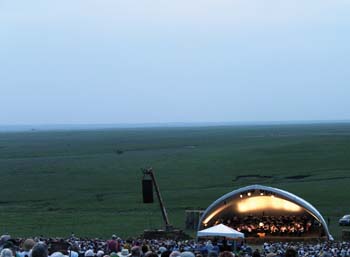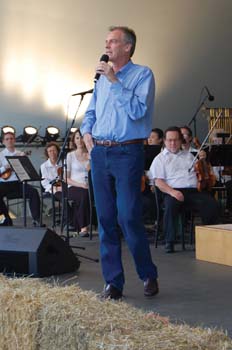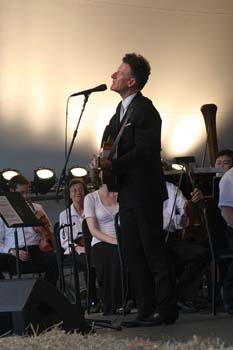
“I’ve been asked to give the welcome speech tonight, and I just can’t do it. I can’t give that same old ordinary, boring, safe welcome that you’ve heard me give so many times. I can’t do it, because tonight is no ordinary, boring night. Tonight is a night that I can only describe as a pure Kansas night.”
Opening with those words, Gov. Mark Parkinson '80 spun a Kansas rhapsody in his welcome of some 7,000 guests to the South Clements Pasture not far from Bazaar in the Flint Hills. They came from all points of the compass to this particular part of what’s left of North America’s tallgrass prairie for the fifth annual Symphony in the Flint Hills.
Scores of Shockers were among the crowd — including 21 Wichita State students who spent the month of June working on a media project with the clearly stated but surely impossible mission of portraying the June 12, 2010 event and “everything surrounding it.”
Symphony in the Flint Hills is spectacularly more than a concert in a pasture. It’s even more than a 90-minute performance by the Kansas City Symphony featuring guest artist Lyle Lovett, with the natural beauty of native prairie as backdrop.
More than six years ago now, Symphony in the Flint Hills Inc. was formed to bring music and prairie lovers together, and to increase awareness and appreciation of the unique ecosystem of the tallgrass prairie. The concert is the closing note of a daylong series of activities that include educational sessions about life on the prairie, locally prepared food and a prairie art auction.
“When I go to the symphony tucked away in the heart of the Flint Hills, for a city girl, it’s like a beautiful secret being shared,” says Vickie Mork ’72/02 of Wichita. Mork, who holds an undergraduate degree in art history and a graduate degree in public administration from Wichita State, was one of dozens of event attendees interviewed by student participants of the Flint Hills media project, a four-week summer seminar class offered by WSU’s Elliott School of Communication.
Taught by Les Anderson, professor of communication, and Amy DeVault, instructor of digital media, the seminar offered both graduate and undergraduate students the opportunity to interview, write and shoot photos and video. The class produced a full-color, glossy, commemorative magazine, Symphony in the Flint Hills: WSU Flint Hills Media Project, as well as video pieces for the web and a 30-minute documentary for KPTS, Wichita’s public television station.
“The project,” Anderson says, “was a great way for students to see a part of Kansas many had not seen. It also gave them hands-on experience covering an event that draws thousands to a Flint Hills pasture each year.” DeVault adds, “I am thankful to everyone who was so gracious to our students. They learned about journalism, but just as important, they learned about the Flint Hills and the wonderful people there.”
One of the students, Jillian Blackburn, reports, “Before this, I didn’t even know what the Flint Hills were. Now I feel like I could give a lecture on them.”
“Instant immersion” was the way another student described the Flint Hills media project. “With such a compressed timetable and ambitious goals for what we would produce, it was exciting,” says Steven Ludlow, a senior in electronic media.
“We talk a lot about new media and convergence journalism,” DeVault says. “In this project, students practiced it. Every student did more than interview and write. Most shot photos, many shot video, and several worked on the design and layout of the magazine. They worked as a team.”
In addition to WSU students Blackburn and Ludlow and faculty members Anderson and DeVault, the complete Shocker team roster lists Corin Brena, Courtney Crain, Taylor Dietterich, Jeff Fletcher, Stepheny Frederiksen, Stacy Hornbeck, Patrice Hein, Mark Kenny, Lakisha Lane, Courtney Looney, Fletcher Powell, Evan Ricker, Nicole Ruvolo, Daphne Sierra ’09, Monica Salmeron ’08, Robert Tolley, Sara Turner, Megan Tyner ’02 and Elizabeth Winterbone.

'80 welcomes the crowd to the
5th annual Symphony in the
Flint Hills.
Wichita State staff members Greg Matthias, Rik Dubiel ’04 and Brody Latham ’10 of the Media Resources Center covered the students as they worked in the Flint Hills, and are now finishing up a documentary about the media project. An air date for the show is being set on WSU Cable Channel 13.
Matthias, the MRC’s manager of video services, explains the genesis of the documentary, “In 2009, we produced a ‘Wichita State and the World’ program about Les’ class that covered the Greensburg tornado and the town’s rebirth. During production of that show, we mentioned to Les that it would be nice to cover one of his classes from the beginning, so we could follow along with the students as they covered their stories.
“So when the Symphony in the Flint Hills class was being formed, Les contacted us and offered the MRC the opportunity to get in on the ground floor, to follow along with him, Amy and the students as they gathered their stories for the magazine.”
The documentary will feature Anderson, DeVault and four of the 21 WSU students: Kenny, a videographer and photographer; Looney, a reporter and photographer; Tolley, who worked in media relations and multimedia; and Ruvolo, a reporter and photographer.
“We followed the students the day of the symphony event and then captured interviews with them afterwards to get their accounts and impressions of the event and the class,” Matthias says. “The Symphony in the Flint Hills was an amazing event that offered the students a wonderful visual palette to publish stories about the people of the Flint Hills and their efforts to preserve this wonderful treasure.”
All together, members of the project team penned 42 articles for their magazine and had stories published in the Wichita Eagle, Lawrence Journal World, Ottawa Herald, Gardner News, Spring Hill New Era, Marysville Advocate and Turnpike Times. Their story subjects range from profiles of event organizers (Emily Hunter, for example, who’s the executive director of Symphony in the Flint Hills) and performers, to descriptions of the event proper, to wider tales of those who inhabit the Flint Hills — and of the hills themselves.
Several of the magazine articles, including one titled simply “Flint Hills,” note the unique nature of the land. “The Flint Hills are special because they are the last significant expanse of virgin tallgrass prairie that exists on the North American continent,” Linda Craghead, the 2010 site manager, is quoted as explaining. “If we are not careful, we will lose the 3 percent that we currently have, and we can’t ever replace it. What I want to do is give people the opportunity to come out here and see why it’s so important to the world.”
“There are so many people dedicated to preserving the Flint Hills,” says Blackburn, a senior at Wichita State. “It’s just wonderful to see how passionate they are about it.”
Ruvolo says that the beauty of the Flint Hills led her to “the realization that Kansas is a unique, wonder-filled place, inhabited by caring people who are as proud as I am now to call Kansas their home.”
One of the caring people Ruvolo met during her time in the Flint Hills is Kevin Krehbiel of rural Inman, Kan. Krehbiel and his family have attended all five of the Symphony in the Flint Hills events, where he and his horses, Maud and Queen, offer wagon rides to attendees. Krehbiel is the subject of Ruvolo’s article “What It Means to Be a Cowboy,” in which she quotes him as describing the tallgrass prairie this way: “This is just one step from heaven. It’s as beautiful as can be. It has the best grass in the world. It’s a great place for cattle to graze, and it’s a livelihood for many a cowboy.”
Looney wrote about one of those cowboys, Flint Hills native Jim Hoy. “Since the 1870s,” Looney writes, “the Hoy family roots have been planted near Cassoday in the Flint Hills.” She goes on to report that in addition to ranching, Hoy is an English professor at Emporia State University. And she captures his description of the land he calls home: “I have realized just how special and different this place is. There is only a small part of the tallgrass left, and from what I can tell, there is just no other place like this in the world.”
With a touch of whimsical thinking, Fletcher has this to say about the charm of the Flint Hills: “I’m not sure what thoughts the cattle and horses and wildlife of the Flint Hills think, but I’m pretty sure I saw some of them shake their heads in disbelief as they watched people drive away back to their hurried, hectic lives.”
Perhaps not surprisingly, Fletcher is the writer of “Five Thing to Know about Prairie Chickens,” which occupies Page 93 of the project magazine’s 100 pages. Other wildlife-focused pieces are “Wildlife: Flint Hills a Sanctuary for Animals and Insects” by Lane and “Wildflowers: An Unexpected Treat for Flint Hills Visitors” by Sierra, who notes that the Symphony in the Flint Hills “is not only about the symphony, but about learning and enjoying the beauty of the tallgrass prairie.” She goes on to report that members of the Kansas Native Plant Society were on hand to lead prairie tours so that concert-goers could learn about native grasses and wildflowers before the music began.
Among the many other activity options for Flint Hills visitors before the Kansas City Symphony took center stage was an instrument petting zoo, where instruments of all stripes – strings, brass, woodwinds and percussion – were available for hands-on experimentation.

performs.
As the sun lowered in the western sky, members of the Kansas City Symphony picked up their instruments and began tuning them in preparation for a 90-minute performance. This year, Grammy award-winning singer/songwriter Lyle Lovett joined the symphony onstage as guest artist, performing three songs from his newest album.
Ludlow, the WSU student who interviewed and wrote the magazine piece about Lovett, reports the performer’s impression of the event: “What makes it amazing, besides just how majestic it is, when you see the effort put into this event – all the people who have volunteered their time – the amount of organization it takes to bring something like this out to where there’s no power – where people can’t talk on cellphones, but talk to one another. It’s very inspiring, isn’t it?”
In her article, “Kansas City Symphony, a Big Part of the Sensory Delight,” Blackburn covers the key role the symphony plays in the success of the event. Two of the personalities she writes about are Frank Byrne, symphony executive director, and conductor Steven Jarvi. In explaining just how popular the event has grown to be, she offers up proof in a quote from Byrne: “We sold this event out in less than two hours. So we had people lining up to our offices, clamoring for tickets.”
Blackburn goes on to explain that Kansas City Symphony and Symphony in the Flint Hills organizers work closely on every aspect of the performance. They collaborate on the music selections, and commiserate on the logistical challenges of putting on a major concert – in the middle of a pasture.
Blackburn writes, “Since the prairie is wide open, explains Bruno Walter, associate conductor, ‘there is nothing for the sound to bounce off of.’ Extra speakers are used to make up for the lack of a traditional setting.”
Of course, that lack is the unique attraction of the event. The Flint Hills are, as conductor Jarvi notes, “one of the most unique ecological places in the world. Just driving out to the site for the first time took my breath away. This is a special place, and it needs protecting.”
This year, Wichita State students and faculty members are certainly doing their part in communicating the importance and charming uniqueness of Kansas’ Flint Hills. As Professor Anderson sums up, “It’s amazing what a group of dedicated, hard-working students can accomplish in a short period of time. What they produced is of value to them personally, but more importantly, to the Symphony in the Flint Hills organization.”





